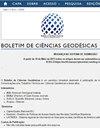通过不同卫星定位方法对智能手机GNSS原始数据进行后处理,评估定位质量
IF 0.5
Q3 Earth and Planetary Sciences
引用次数: 0
摘要
摘要:自2016年8月Android 7推出以来,在一些Android智能手机和平板电脑中使用GNSS传感器收集的原始数据已经成为可能。因此,第一次有可能对数据进行后处理,这意味着获得比通常更精确的坐标,从米到分米。此外,在通过智能手机进行定位的技术创新中,提到了现代GNSS传感器的使用,例如小米Mi 8使用的传感器,这是第一款集成双频GNSS传感器的智能手机。在本研究中,数据收集活动在静态模式下进行,以评估从Mi 8获得的大地测量坐标的质量。使用免费的应用程序将原始数据存储在RINEX格式的文件中,使用不同的定位方法和不同的软件对数据进行后处理,包括巴西免费提供的IBGE-PPP在线服务。研究结果表明,该方法可以获得分米级精度的大地坐标,这表明该方法可用于某些工程应用。本文章由计算机程序翻译,如有差异,请以英文原文为准。
EVALUATION OF THE POSITIONAL QUALITY THROUGH THE POST-PROCESSING OF RAW GNSS DATA FROM A SMARTPHONE VIA DIFFERENT SATELLITE POSITIONING METHODS
Abstract: Since the introduction of the Android 7 in August 2016, it has become possible to use raw data collected by GNSS sensors present in some Android smartphones and tablets. Therefore, it became possible, for the first time, to perform the post-processing of the data, which means to obtain coordinates that are more accurate than usual, from meters to decimeters. In addition, among the technological innovations in the context of positioning via smartphones, it is mentioned the use of modern GNSS sensors, like the one used by Xiaomi Mi 8, which was the first smartphone to integrate a dual-frequency GNSS sensor. In this research, data collection campaigns were carried out in static mode to evaluate the quality of geodetic coordinates obtained from Mi 8. Using freely available applications that store raw data in files in RINEX format, the data was post-processed with different positioning methods and with different software, including the freely available IBGE-PPP online service in Brazil. The results of this research show that it is possible to obtain geodetic coordinates with an accuracy at decimeter order, which indicates that the methodology can be used in some engineering applications.
求助全文
通过发布文献求助,成功后即可免费获取论文全文。
去求助
来源期刊

Boletim De Ciencias Geodesicas
Earth and Planetary Sciences-General Earth and Planetary Sciences
CiteScore
1.70
自引率
20.00%
发文量
10
审稿时长
3 months
期刊介绍:
The Boletim de Ciências Geodésicas publishes original papers in the area of Geodetic Sciences and correlated ones (Geodesy, Photogrammetry and Remote Sensing, Cartography and Geographic Information Systems).
Submitted articles must be unpublished, and should not be under consideration for publication in any other journal. Previous publication of the paper in conference proceedings would not violate the originality requirements. Articles must be written preferably in English language.
 求助内容:
求助内容: 应助结果提醒方式:
应助结果提醒方式:


